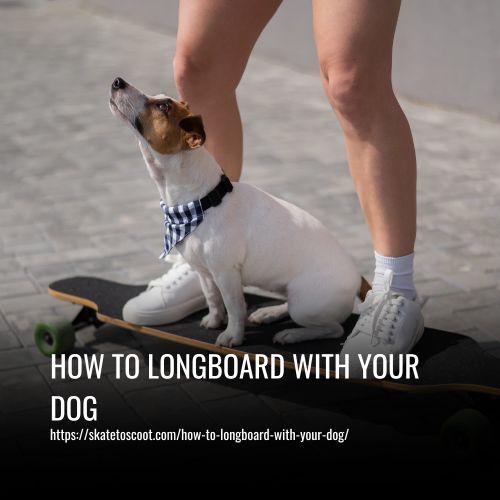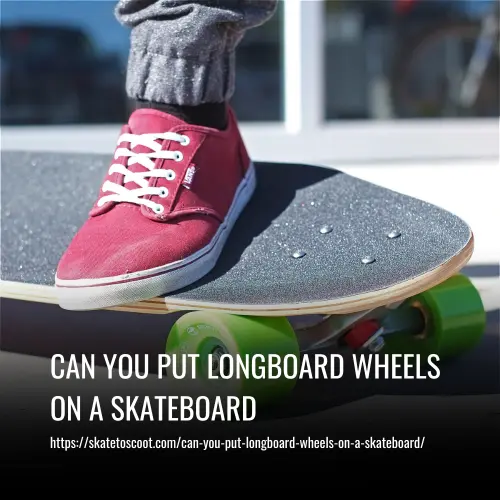As an Amazon Associate we earn from qualifying purchases.
Are you tired of going on the same old walks with your dog? Looking for a fun and exciting way to bond with your furry friend while getting some exercise? Look no further than longboarding with your dog! Longboarding with your dog is a thrilling activity that allows you to enjoy the outdoors together and experience a new level of adventure.

How to Longboard with Your Dog
Longboarding with your dog can be a thrilling and fun activity, but it requires some preparation and training. Here are some tips to help you get started:
- Choose the right dog breed: Larger breeds such as German Shepherds and Pit Bulls are often better suited for longboarding due to their size and strength.
- Get the right equipment: Opt for a longboard with a wide deck and soft, larger wheels. This will provide stability and a smoother ride for both you and your furry friend.
- Train your dog: Start by teaching your dog basic commands such as sit, stay, and come. Gradually introduce the longboard by having your dog walk alongside it, rewarding them with positive reinforcement for following instructions.
- Practice urban mushing: Urban mushing is a dog-powered sport that involves dogs pulling a wheeled vehicle. It’s a great way to train your dog to pull and work together with you on the longboard.
- Start slow: Begin by pushing the longboard while your dog walks alongside you. Once they are comfortable, you can progress to a slow jog or trot.
- Use verbal commands: Teach your dog specific commands for starting, stopping, and turning. This will help you communicate effectively while longboarding.
- Ensure safety: Check your longboard regularly for any potential hazards and always wear protective gear. Remember to give your dog frequent breaks and consider their physical capabilities.
By following these steps and spending time building your dog’s skating skills, longboarding with your dog can become a fun and enjoyable activity for both of you. Just remember to start slow, be patient, and have fun!
Best Dog Breeds for Longboarding
Longboarding with your dog can be a fun and active way to spend time together. However, not all dog breeds are well-suited for this activity. Here are some of the best dog breeds for longboarding:
- Husky Breeds: Huskies and other similar breeds, like Alaskan Malamutes, were bred for mushing and pulling sleds. Their natural inclination to run and pull makes them excellent companions for longboarding. These high-energy dogs can provide a thrilling and exhilarating experience on the board.
- Pitbulls: Pitbulls are known for their strength and athleticism. They have a natural drive to be active and thrive on physical challenges. Pitbulls can make great longboarding partners, whether they are pulling you like a chariot or running beside you.
- Retriever Breeds: Retrievers, such as Labrador Retrievers and Golden Retrievers, are highly energetic and eager to please. They are natural athletes and enjoy being active with their owners. Retrievers can easily keep up with the pace of a longboard and make great companions on your rides.
- Cattle Dogs: Breeds like Australian Cattle Dogs and Border Collies are known for their agility and endurance. These dogs have a strong work ethic and are always up for a challenge. Cattle dogs can easily adapt to longboarding and will enjoy the physical and mental stimulation it provides.
- Terriers: Terrier breeds, such as Jack Russell Terriers and Rat Terriers, are lively and agile dogs. They have a lot of energy to burn and will happily keep up with you on your longboarding adventures. Terriers can be great fun to have around and will add excitement to your rides.
- Medium to Large-sized Dogs: Generally, medium to large-sized dogs are better suited for longboarding due to their physical capabilities. Their size and strength make them more stable on the board and they can easily match your pace. Some examples of medium to large-sized breeds that can excel at longboarding include German Shepherds, Boxers, and Pointers.
When choosing a dog breed for longboarding, it’s important to consider their energy levels, physical capabilities, and temperament. Remember to always consult with a dog trainer or veterinarian if you have any concerns or questions regarding your dog’s suitability for longboarding.
Common Mistakes for Longboarding with your Dog
When longboarding with your dog, it’s important to be mindful of common mistakes that can lead to injuries or accidents. One common mistake is bringing your dog to a skatepark. Skateparks are not suitable for dogs, especially if it’s their first time. The different cement surfaces can cause your dog to slip and get injured, and the distractions of people, noises, and other dogs can make it difficult for you to maintain control. Additionally, skateparks have unpredictable factors like kids and boards shooting out in all directions.
Another mistake is longboarding with your dog on a regular longboard if you’re not an experienced skateboarder or longboarder. Longboarding with your dog can be very dangerous, as your dog’s pulling can cause you to reach high speeds quickly, making it difficult to stop or control your direction.
It’s also important to consider your dog’s paws when longboarding. Dogs must be able to handle the wear and tear on their front and back paws, so it’s crucial to choose smooth surfaces and avoid areas with debris or gravel that can cause paw injuries.
Proper leash and maneuvering techniques are essential to prevent accidents. Keeping a safe distance from your dog and being aware of their speed fluctuations can help avoid collisions or sudden stops.
How To Longboard with Your Dog
Longboarding with your dog can be a fun and exciting activity, but it’s important to do it safely and responsibly. Here are some tips and guidelines to ensure a great experience for both you and your furry friend:
1. Choose the Right Equipment:
– Opt for a longboard with a wide deck and soft wheels. This helps provide stability and a smoother ride for both you and your dog.
– Consider using larger wheels as they can handle rough surfaces better.
– Ensure your longboard has tight trucks, which makes it easier to control your board.
2. Train Your Dog:
– Before you even think about longboarding with your dog, make sure they have basic obedience training and can respond to verbal commands.
– Teach your dog basic commands such as “sit,” “stay,” and “come” to ensure they can follow your instructions while on the longboard.
3. Start Slow and Gradually Increase:
– Begin with short periods of time on the longboard, gradually increasing the duration as your dog becomes more comfortable.
– Be mindful of your dog’s physical limitations, especially if they are a larger breed or still in their growth phase with developing growth plates.
4. Use Positive Reinforcement:
– Reward your dog with treats and praise when they exhibit good behavior while longboarding.
– Positive reinforcement helps your dog associate longboarding with a fun and enjoyable activity.
5. Use Proper Leash and Safety Gear:
– Use a leash that is specifically designed for dog-powered sports, like urban mushing.
– Avoid retractable leashes as they can be challenging to control and may cause accidents.
– Consider using an actual mushing harness as it provides better support and control.
– It’s crucial to wear protective gear such as a helmet and knee pads to prevent any injuries.
6. Start on Smooth Surfaces:
– Begin on a smooth surface to allow your dog to get used to the board’s movement and build muscle memory.
– Avoid areas with debris or rough terrain that could cause paw injuries or make it difficult to maneuver.
7. Practice Proper Longboarding Techniques:
– Maintain a safe distance between you and your dog to prevent collisions or sudden stops.
– Practice proper foot braking techniques to ensure you can control your speed and come to a stop when needed.
Longboarding with your dog can be a fun and rewarding experience, strengthening the bond between you and your furry companion. Just remember to prioritize safety, choose the right equipment, and provide proper training to make it an enjoyable activity for both of you.
Tips to Longboard with a Dog
Longboarding with your dog can be a thrilling experience, but it’s essential to take the necessary precautions to ensure a safe and enjoyable ride. Here are some tips to help you make the most out of your longboarding adventures with your furry friend:
- Lower Your Center of Gravity: To maintain balance and stability while longboarding with your dog, lower your center of gravity by crouching down as low as you can. This helps you stay at the same level as your dog, creating a better connection and enhancing the overall experience. Aim to be neck and neck with your dog by crouching down like a frog on a lily pad.
- Be Comfortable Skating Fast: Certain dog breeds can run at speeds exceeding 25 mph, so it’s crucial to be comfortable with skating fast. If you plan to longboard with your dog on a leash, be prepared for high speeds. Consider taking your back foot off the board and letting it drag if you need to slow down or tighten your trucks to reduce turns on your path.
- Master Your Leash: The leash you use while longboarding with your dog is of utmost importance for safety. Ensure that the leash is long enough for maneuvering with your dog but not so long that it poses a danger of going under your wheels. It’s essential to understand when to choke up or let loose the leash and swing it around from left to right. Mastering leash control is a necessary skill to ensure a safe and enjoyable ride.
- Choose the Right Equipment: Selecting the right equipment is crucial for a smooth and safe longboarding experience with your dog. Opt for a longboard with a wide deck, soft wheels, and tight trucks. A wide deck provides stability, while soft wheels provide a smoother ride. Tight trucks make it easier to control your board. Additionally, consider using larger wheels to handle rough surfaces better.
- Gradual Training and Positive Reinforcement: Before hitting the streets, ensure that your dog has undergone basic obedience training and can respond to verbal commands. Start slow and gradually increase the duration of your longboarding sessions as your dog becomes more comfortable. Use positive reinforcement techniques, such as treats and praise, to reward good behavior and make longboarding an enjoyable activity for your dog.
Remember, safety should always be a priority when longboarding with your dog. Wear protective gear, such as a helmet and knee pads, and choose a suitable location with a smooth surface to avoid any potential hazards. By following these tips, you can create unforgettable experiences while longboarding with your furry friend.
Safety tips for longboarding with a dog pulling
- Wear Protective Gear: To ensure your safety while longboarding with a dog pulling, always wear a longboard helmet and pads, including knee and elbow pads, wrist guards, and padded shorts. This will protect you from potential injuries in case of falls or accidents.
- Use Recommended Equipment: Invest in high-quality longboarding equipment that is specifically designed for dog pulling. Some recommended brands include Pro-Tec, Triple 8, and Loaded. This includes a certified helmet, slide gloves, and knee and elbow pads.
- Don’t Ride in Front of Your Dog: Avoid riding in front of your dog while carving downhill. Dogs can suddenly change directions, pulling you off your longboard and causing accidents. Stay behind or next to your dog to maintain control and minimize risks.
- Avoid Putting Your Hand Inside the Leash’s End Loop: It’s important not to put your hand inside the leash’s end loop. This ensures that you can easily let go in case of any trouble or if you fall. If your hand is inside the loop and you fall, the dog will continue pulling and prevent you from catching yourself with your arm.
- Train Your Dog to Slow Down or Stop: Before going longboarding with your dog pulling, train them to respond to verbal commands to slow down or stop. This will give you better control over your speed and prevent any potential accidents or mishaps.
- Master Foot Braking: It’s essential to master foot braking before going longboarding with your dog. Foot braking involves using your foot to gradually slow down or stop the longboard. This skill will help you maintain control and ensure your safety during the activity.
By following these safety tips, you can enjoy the thrilling experience of longboarding with your dog pulling while minimizing risks and ensuring the safety of both you and your furry companion.
FAQs
Longboarding with your dog can be safe if certain precautions are taken. It’s important to ensure both you and your dog are properly trained and equipped. Always wear protective gear and use recommended equipment for dog pulling. Additionally, monitor your dog’s strength and exhaustion levels, take breaks when needed, and avoid riding in front of your dog to minimize risks.
Longboarding with your dog is best suited for larger breeds that have the strength and endurance to keep up. Breeds like German Shepherds or Pit Bulls tend to excel in dog-powered sports. It’s important to consider your dog’s fitness level, age, and overall health before attempting longboarding together. Consult with your vet to determine if your dog is physically ready for this activity.
Training your dog to longboard requires teaching them basic commands, such as slowing down or stopping, through positive reinforcement. Start by introducing your dog to the longboard in a safe and controlled environment. Gradually increase the distance and duration of the rides while reinforcing proper behavior with rewards and praise. Consistency and patience are key in the training process.
The main concerns when longboarding with a dog include the risk of falls and injuries, both for you and your dog. Dogs can suddenly change direction or become distracted, so it’s important to maintain control and stay attentive. Understanding your dog’s limits is crucial, as they may become tired or overheated. Regular breaks are necessary to prevent exhaustion.
To ensure safety, always wear proper protective gear, use reliable equipment, and avoid riding in front of your dog. Stay aware of your dog’s energy levels and rest as necessary. Be cautious of potential hazards and maintain good communication and control with verbal commands and leash handling. Regularly check your equipment and be prepared for any unexpected situations.
Conclusion:
Longboarding with your dog is not only a fun and exciting activity, but it also strengthens the bond between you and your furry friend. By following the steps and tips mentioned in this article, you can create unforgettable memories and embark on thrilling adventures together.
So grab your longboard, leash up your pup, and get ready to hit the pavement in style. Longboarding with your dog is a unique experience that will leave you both smiling from ear to ear!
Amazon and the Amazon logo are trademarks of Amazon.com, Inc, or its affiliates.



